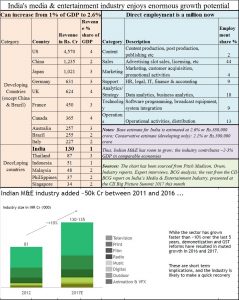http://www.freepressjournal.in/analysis/great-times-ahead-for-infotainment-industry/1182960
India’s media industry can do a great deal better
— By | Dec 07, 2017 07:15 am
It could be the industry which offers people the best of hopes; but it is an industry that could turn most cynical as well. The potential for the growth for India’s media and entertainment industry is phenomenal. But coming at a time when the government permits visceral cries for the ban of a dance bar, or a movie, or even a poet, there are genuine fears this potential could get aborted.
But the fact is that this industry has done marvelously till now – without much support from the government. It has been entirely a home-grown initiative propelled by individual dreams and visions. Bollywood grew without any official access to funds. So, did cinema. Unlike theatre, which often had a patron saint in the state, cinema grew largely on its own steam. The computer animations industry too grew of its own volition. Their success underscores the ability of Indians to rise and thrive – in spite of the government.
Today this industry accounts for total revenues of around Rs 135,000 crore. It has been growing at an impressive rate of 10% a year (see chart alongside) and it already employs around a million people, both directly and indirectly. This includes people from content, sales, marketing, technology, support and operational sectors. But it accounts for barely 1% of GDP.

 This share of GDP could go up to 2.6%, says the CII-BCG report (a copy of the executive presentation can be downloaded from http://www.asiaconverge.com/wp-content/uploads/2017/12/2017-12_COO-BCG-report-entertainment-and-media2.pdf). That would be in keeping with the share this industry enjoys in other countries. If, India achieves a share of the minimum expected 2.1% of GDP, this industry could achieve a turnover of Rs 300,000 crore. If a normal growth curve materialises, it could mean annual billings of Rs 380,000 crore and a job potential of around 4 million.
This share of GDP could go up to 2.6%, says the CII-BCG report (a copy of the executive presentation can be downloaded from http://www.asiaconverge.com/wp-content/uploads/2017/12/2017-12_COO-BCG-report-entertainment-and-media2.pdf). That would be in keeping with the share this industry enjoys in other countries. If, India achieves a share of the minimum expected 2.1% of GDP, this industry could achieve a turnover of Rs 300,000 crore. If a normal growth curve materialises, it could mean annual billings of Rs 380,000 crore and a job potential of around 4 million.
Crucially, as CII points out, this growth can be achieved without much spending from public infrastructure. Digital platforms have been proliferating giving birth to opportunities that did not exist before – especially for creators, storytellers and technology providers.
Skilling will remain a major challenge. With school education continuing to hurtle downwards in terms of quality, most families have to take recourse to private education and outside support for honing the skills of children. But, despite all this, the growth potential remains strong. This will provide an opportunity for start-ups as well as established media companies to participate in the growing global M&E market.
According the CII-BCG report media industry workforce will be unrecognisable in 2022. Major shifts around adoption of technology, big data and analytics as well as structural changes will mean many new job roles and a massive reskilling of the current workforce. The M&E industry alone will require 140-160K trained/employable individuals entering the workforce every year for the next 5 years.
That in turn will mean that the government itself will have to recognise the need to allow the private sector to participate in setting up skill-development institutes. Some of it could be as offers of land and financial incentives – even if they are as long term soft loans.
Crucially, the government will have to unlearn a few things. First, it must forget trying to mend anything that is already functioning quite well. A good example is the unfortunate appointment of a director for the Film and Television Institute of India (FTII) which neither the students nor the industry wanted.
Second, the government must unlearn trying to control a vibrant industry through bans and censorship. Bans and censorship are antithetical to the creative spirit. Instead the government must use the system of certification to guide people on the suitability or otherwise of watching films. Bans do not work over a long term. Just look at the number of downloads of censorious content from the net every hour, and it will become clear that people will always get what they want. If the government does not allow it openly, it will seek it out clandestinely.
A good government works towards making things transparent and encourages all demands to come out into the open space. Pushing demand underground hurts everybody. It hurts the credibility of the government. It further corrodes the morale of its police and regulatory authorities who become more susceptible to bribes and inducements. And it hurts the customer, who is compelled to seek out such films through subterfuge and stealth.
The government’s constant eagerness to use bans as solutions is visible elsewhere as well. Look at the legislative time Maharashtra (and a few other states) has spent in trying to ban girls dancing in bars. It’s become almost laughable. Overnight, the government has converted its police into Peeping Toms, peering into bars and parlours.
That is why, if the government wants media and entertainment to do well, it must learn to be more benign. The industry’s share to GDP is already quite low. Keeping it stunted will only harm the nation.





































COMMENTS